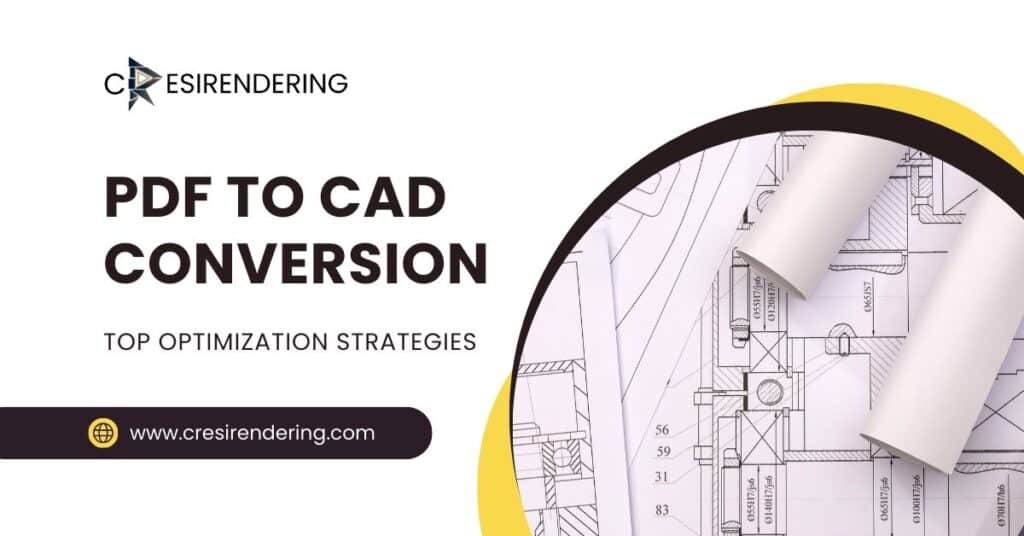Discover precision and efficiency in design workflows with top strategies for Optimizing PDF to CAD conversion. Elevate your projects seamlessly.

Introduction
In today’s fast-paced technological landscape, optimizing PDF to CAD conversion processes is imperative for businesses seeking efficiency in design and engineering workflows. As a leading authority in the field, we understand the critical role of streamlined conversion in enhancing productivity and reducing errors.
AEC professionals worldwide often need to convert PDF drawings or blueprints of old or heritage projects to usable AutoCAD drawings. The applications of AutoCAD drawings are diverse and include effective decision-making, strategizing, BIM modeling, and cost estimation.
This comprehensive post delves into strategies and best practices that go beyond the basics, ensuring a seamless PDF to CAD Conversion.
Understanding the Importance of PDF to CAD Conversion
Efficiency in Design Iterations
Efficient CAD conversion is not merely about transferring files; it’s about enabling swift design iterations. Engineering teams can expedite project timelines and respond promptly to evolving requirements by optimizing PDF to CAD Conversion. This agility sets the foundation for innovation and seamlessly incorporates design modifications.
Precision in Measurements and Scaling
One of the critical challenges in Optimizing PDF to CAD conversion lies in maintaining precision in measurements and scaling. Our advanced techniques prioritize accuracy, guaranteeing that the converted CAD files mirror the exact specifications of the original design. This meticulous approach eliminates the risk of errors and discrepancies in the final output.
Strategies for Optimizing PDF to CAD Conversion
1. Advanced OCR Technology
Integrating advanced Optical Character Recognition (OCR) technology is a game-changer in the PDF to CAD conversion realm. This cutting-edge approach enables the extraction of text data from scanned PDFs with unparalleled accuracy. By incorporating OCR, our conversion processes transcend traditional boundaries, capturing intricate details crucial for CAD designs.
2. Layer Recognition and Management
A critical aspect often overlooked is the efficient handling of layers during conversion. Advanced tools allow recognizing and managing layers, preserving the integrity of complex designs.
This facilitates easy editing and ensures that the converted CAD file maintains the hierarchical structure of the original design, a crucial consideration in intricate projects.
3. Automated Vectorization Techniques
Many consultants employ automated vectorization techniques to elevate the quality of PDF of DWG conversions. This sophisticated approach transforms raster images within PDFs into scalable vector graphics, enhancing the clarity and resolution of the final CAD output. Automating this intricate process significantly reduces manual intervention, minimizing the likelihood of errors.
Also Read, Effortlessly Convert PDF in AutoCAD
Implementing Best Practices for Seamless Conversion
Customization for Industry-Specific Requirements
Recognizing the diverse needs of industries, our PDF to CAD conversion process is tailored to meet sector-specific requirements.
Whether it’s architectural designs, mechanical drawings, or electrical schematics, our customization ensures that the converted CAD files align seamlessly with the standards and specifications of the respective industry.
Quality Assurance Protocols
At the heart of our conversion methodology lies a robust quality assurance framework. Rigorous testing and validation processes are integrated to guarantee the accuracy and fidelity of the converted CAD files. This commitment to quality sets us apart, ensuring that our clients receive deliverables that surpass industry benchmarks.
The Road Ahead: Future-Proofing CAD Conversion
Embracing Cloud-Based Solutions
As technology evolves, so do our strategies for PDF to CAD conversion. Embracing cloud-based solutions is a critical component of future-proofing this process. This approach not only enhances accessibility but also enables collaborative workflows, allowing geographically dispersed teams to contribute to project design in real-time seamlessly.
Integration with BIM for Holistic Project Management
Looking beyond traditional conversion, our forward-looking approach involves the integration of Building Information Modeling (BIM).
By aligning CAD conversions with BIM principles, we empower project stakeholders with a holistic view of the construction process. This integration streamlines collaboration, enhances decision-making, and contributes to the project’s overall success.
Conclusion
Optimizing PDF to CAD conversion is not just a technical necessity; it’s a strategic imperative for businesses aiming to stay ahead in today’s competitive landscape.
Our commitment to excellence, advanced technologies, and industry-specific customization positions us as the preferred choice for organizations seeking a reliable partner for their CAD conversion needs.
Frequently Asked Questions By Our Clients
What is the Importance of optimizing PDF to CAD conversion in design workflows?
Efficient PDF to CAD conversion is crucial for design workflows as it accelerates design iterations, enables quick responses to project changes, and fosters innovation. This optimization ensures that design modifications are seamlessly incorporated, enhancing productivity.
How does advanced OCR technology contribute to PDF to CAD conversion optimization?
Advanced Optical Character Recognition (OCR) technology plays a pivotal role by accurately extracting text data from scanned PDFs. This technological advancement ensures that intricate details within PDFs are captured precisely, contributing to the overall accuracy of CAD designs.
Why is layer recognition and management essential in the PDF to CAD conversion?
Efficient handling of layers during conversion is critical for preserving the integrity of complex designs. Recognizing and managing layers ensures that the converted CAD file maintains the hierarchical structure of the original design, facilitating easy editing and preserving the intended visual hierarchy.
How do automated vectorization techniques enhance the quality of PDF of DWG conversions?
Automated vectorization techniques transform raster images within PDFs into scalable vector graphics, improving clarity and resolution. Automating this process minimizes manual intervention, reducing the likelihood of errors and contributing to the overall quality of the CAD conversion.
How does customization for industry-specific requirements impact the PDF to CAD conversion process?
Customization for industry-specific requirements ensures that the converted CAD files align seamlessly with the standards and specifications of the respective industry. Whether it’s architectural designs, mechanical drawings, or electrical schematics, this tailored approach enhances the relevance and applicability of the CAD conversion.
How does integrating CAD conversion with Building Information Modeling (BIM) contribute to holistic project management?
Integrating CAD conversion with BIM principles provides a holistic view of the construction process. This integration enhances collaboration among project stakeholders, improves decision-making processes, and contributes to the project’s overall success by aligning design information with broader project management goals.
Email Us
Let's Talk
USA - (+1) 760 514 0172
INDIA - (+91) 63502 02061




